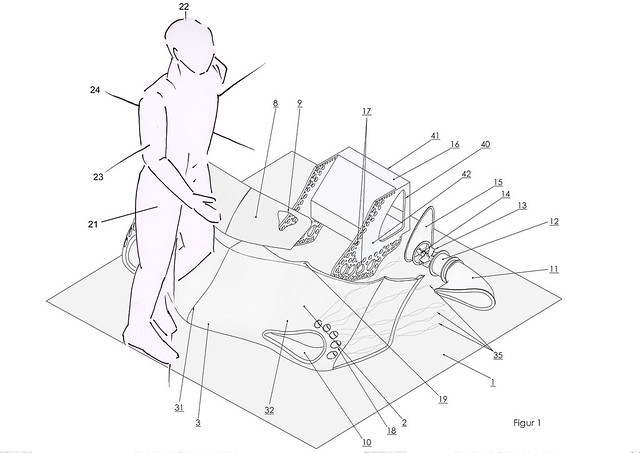Hello,
last year, I tried to register a patent for pedestrian safety.
But it failed because it is not different enough to existing patents.
That shows, that a method to protect pedestrians is clear, but not completely allowed by law.
After my opinion, manufacturers have a strong lobby to protect their brands. One most important way is to show the radiator grill.
What I try to say: excellent aerodynamics and pedestrian safety in one solution are possible. But there is a need for change the law.
Patent registration in german language.
Abstract
Zusammenfassung
Aufgabe 1 (Task)
Fußgänger sind bei Verkehrsunfällen mit Kraftfahrzeugen besonders gefährdet. Eine neue
Gefahrenquelle sind leise Elektrofahrzeuge die von Fußgängern oft später wahrgenommen
werden. Aufgabenstellung ist die Verbesserung der der passiven Sicherheit eines
mehrspurigen Kraftfahrzeuges im Fall einer frontalen Kollision mit einem Fußgänger.
Solution
Lösung 1
Durch eine neuartige Formgebung wird der Stoßfänger/Spoiler kippt Fußgänger bei einer
Kollision auch seitlich so dass eine Abrollbewegung auf dem Fahrzeug eingeleitet wird.
Aufgabe 1 ist durch eine geänderte Kinematik des Fußgängerfrontalaufpralls gelöst.
Patent Description
Beschreibung
Die Erfindung betrifft die Frontverkleidung für Kraftfahrzeuge vor einer innen liegenden
Stoßstange, die Änderung der Kinematik des Fußgängeraufpralls an der Fahrzeugfront, die
Verringerung des Luftwiderstandes am Fahrzeug und die Zuführung der Umgebungsluft zu
fahrzeugseitigen Wärmetauschern.
1 Fußgängerschutz durch Änderung der Kinematik des Fußgängeraufpralls
1.1 Die Aufgabe der Erfindung ist es, den Fußgängerschutz bei Kollisionen von Fußgängern
an der Fahrzeugfront zu verbessern.
Eine hohe Anzahl von Unfällen mit Todesfolge im Straßenverkehr entsteht durch frontale
Kollisionen zwischen Fußgängern und Kraftfahrzeugen. Im Umfeld der Elektromobilität
erhöht sich das Risiko weil diese Fahrzeuge durch Fußgänger akustisch weniger
wahrgenommen werden. Zielsetzung ist die Minimierung der Unfallfolgen bei einem
Fußgängeraufprall an einem Kraftfahrzeug. Für den Fall des frontalen Fußgängeraufpralls
am Kraftfahrzeug soll der Bewegungsablauf so verändert werden, dass die Energie des
Aufpralls besser am Kraftfahrzeug abgeleitet wird und somit die Unfallfolgen verringert
werden.
Zum Stand der Technik gehören integrierte Stoßstangen die mit elastischen Materialien
und einem weichen Frontstoßfänger den Aufprall abmildern. Teils wird versucht, mit
hohen Fahrzeugfronten eine große Kontaktfläche für den Aufprall bereit zu stellen und
durch besser deformierbare Fahrzeugfronten und Motorhauben den Aufprall des Kopfes
abzuschwächen. Gute Ergebnisse mit Serienfahrzeugen werden durch aktive Motorhauben
(pop up hood) erreicht.
Der Bewegungsablauf des Fußgängeraufpralls hat bei den bekannten Systemen
gemeinsam, dass der Fußgänger entsprechend seiner Größe entgegen der Fahrtrichtung
über den Stoßfänger, die Motorhaube und je nach Größe auch bis zur Windschutzscheibe
entgegen der Fahrtrichtung auf dem Fahrzeug abgewickelt wird. Dieser Vorgang wird als
Primärstoß bezeichnet. Nach der Abwicklung auf dem Fahrzeug mit abschließendem
Einschlag des Kopfes katapultiert es den Fußgänger in Fahrtrichtung auf die Fahrbahn
zum so genannten Sekundärstoß der weitere Verletzungen verursacht.
1.2 Die Aufgabe wird durch eine Änderung der Formgebung an der Vorderseite des
Fahrzeuges durch eine Nase (3) mit gepfeilter Vorderkante gelöst. Die Kontakthöhe (26,
- 1 –
27) über der Fahrbahn (1) ist dabei in der Mitte des Unterschenkels eines erwachsenen
Menschen. Bei der Kollision mit einem Fußgänger (21) wird eine Abrollbewegung auf
dem Fahrzeug eingeleitet. Dadurch verändert sich die Kinematik des Fußgängeraufpralls.
Der Fußgänger (21) wird durch die neue Fahrzeuggeometrie bei Kontakt am
Unterschenkel quer zur Fahrtrichtung (33) gekippt so dass eine Abrollbewegung quer auf
dem Fahrzeug eingeleitet wird.
Es entsteht in Folge der Kollision und des seitlichen Kippens eine Rotation des
Fußgängers um dessen Hochachse (22).
Durch das Abrollen auf dem Fahrzeug vergrößert sich die Kontaktfläche (25) zwischen
Fußgänger und Fahrzeug.
Durch die geänderte Kinematik des Fußgängeraufpralls wird Energie großflächiger
verteilt. Die Abrollbewegung reduziert die Wucht des Kopfaufschlages am Fahrzeug.
Kollisionen mit Kinderfußgängern verlaufen günstiger da der Kontakt mit dem Fahrzeug
auf Höhe eines Erwachsenen-Unterschenkels deutlich niedriger ist als bisher.
Es verbleibt durch das Abrollen weniger Energie, die den Fußgänger zum Sekundärstoß
auf die Fahrbahn katapultiert.
Durch die geänderte Geometrie des Fahrzeuges reduziert sich auch das Risiko des meist
tödlichen Überfahrens (Tertiärstoß).
Durch die neue Fahrzeuggeometrie mit dem längeren Frontanbauteil wird an zusätzlicher
Fußgängerknautschzone (20) gewonnen was den Aufprall weiter abmildert.
Das Frontanbauteil wird durch elastische Kunststoffschäume (16, 42) gegen die integrierte
Stoßstange gestützt. Die elastischen Kunststoffschäume sind dabei so angeordnet, dass
diese sich bei einer Kollision durch einen Fußgänger in geeigneter Weise deformieren
lassen.
1.3 Beispiel für den Bewegungsablauf einer Fußgängerkollision an der Fahrzeugfront.
Im Bewegungsablauf wird ein Fußgänger (21) von einem Kraftfahrzeug zwischen der
Nase/Fußgängerkippvorrichtung (3) des Frontanbauteiles (2) und den Unterschenkeln des
Fußgängers (21) erfasst. Durch den Pfeilungswinkel (4) der
Nase/Fußgängerkippvorrichtung (3) wird die Hochachse des Fußgängers (22) quer zur
Fahrtrichtung gekippt. Durch die niedrige Kontakthöhe (26, 27) des Fußgängerschutzes
über der Fahrbahn (1) und den flachen Rückversatzwinkel (5, 6) zwischen der Fahrbahn
(1) und der Tangente über die Fahrzeugfront bekommt der Fußgänger über einen großen
Teil der Körperhöhe Kontakt mit dem Fahrzeug. In Verbindung mit dem seitlichen
- 2 –
Kippen des Fußgängers entsteht eine Rotation des gekippten Fußgängers auf dem
Fahrzeug. Im Ergebnis entstehen weniger Biegemomente am Körper des Fußgängers.
Das Abrollverhalten des Fußgängers auf dem Fahrzeug reduziert die Wucht des
Kopfaufschlages weil die Energie zuvor besser verteilt und abgeleitet wird.
Patent Claims
Patentansprüche
1) Ein mehrspuriges Kraftfahrzeug mit einem Frontanbauteil vor einer innen liegenden
Stoßstange kennzeichnet sich durch eine Nase an dem Frontanbauteil, welche die
Kinematik des Fußgängeraufpralls so verändert dass der Fußgänger seitlich gekippt wird
in Folge dessen eine Abrollbewegung mit geringerem Verletzungsrisiko auf dem
Fahrzeug eingeleitet wird.
a) Die Höhe der gepfeilten Vorderkante der Fußgängerkippvorrichtung des
Frontanbauteiles befindet sich in mittlerer Höhe des Unterschenkels eines
erwachsenen Menschen.
b) Die gepfeilte Vorderkante der Fußgängerkippvorrichtung hat eine Mindestbreite von
28% der Fahrzeugbreite und eine maximalbreite von 82% der Fahrzeugbreite.
c) Der Pfeilungswinkel der Fußgängerkippvorrichtung beträgt mindestens 14°
und maximal 51°


